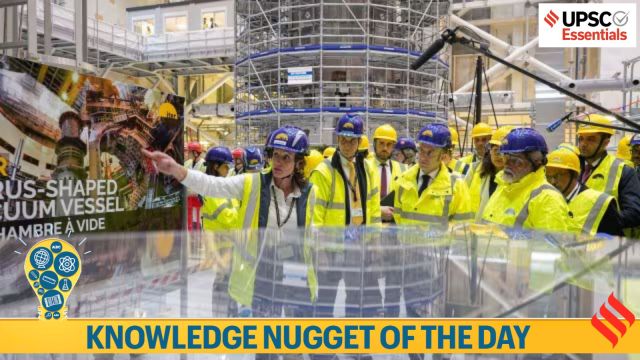Take a look at the essential events, concepts, terms, quotes, or phenomena every day and brush up your knowledge. Here’s your knowledge nugget for today.
Knowledge Nugget: International Thermonuclear Experimental Reactor (ITER)
Subject: International Relations, Science and Technology
(Relevance: The ITER Project is significant for the UPSC CSE in terms of current affairs and Science & Technology. Additionally, the UPSC asked a question about it in the 2016 UPSC CSE prelims.)

Why in the news?
Prime Minister Narendra Modi, on his visit to France to attend an AI summit, also toured the ambitious International Thermonuclear Experimental Reactor (ITER) in Cadarache, accompanied by French President Emmanuel Macron. They were welcomed by the director-general of the facility, and both leaders commended the advancements made at ITER, particularly the assembly of the world’s largest tokamak.
Key Takeaways :
1. ITER is an international collaborative project aimed at building the world’s largest magnetic fusion device, designed to prove the feasibility of fusion as a large-scale and carbon-free source of energy.
2. Presently, as many as 33 nations, including India, are collaborating on ITER project. Seven ITER members — China, India, European Union, Japan, Korea, Russia and United States — have been making joint efforts for decades to build and operate the ITER experimental device.
3. ITER is currently under construction in the south of France. Notably, the idea for the international joint experiment was conceived in 1985. The project, under development since 2005, is slated to become one of the biggest international science facilities in the world. According to its current timeline, it is expected to begin deuterium-tritium fusion reactions by 2039, producing 500 MW of fusion power.
4. ITER would not be converting the output heat energy into electricity. But its success is expected to pave the way for other machines to start using fusion energy as a regular source of electricity generation.
Story continues below this ad
5. According to the ITER website, the primary task of ITER is to investigate and demonstrate burning plasmas — “plasmas in which the energy of the helium nuclei produced by the fusion reactions is enough to maintain the temperature of the plasma, thereby reducing or eliminating the need for external heating”.
6. ITER will also examine the availability and integration of technologies needed for a fusion reactor and the validity of tritium breeding module concepts that would lead in a future reactor to tritium self-sufficiency.
Significance of ITER project
1. Fusion is regarded as the future of energy, promising to free the world from the ongoing search for increasingly efficient energy sources.
2. A very small amount of raw material — deuterium and tritium nuclei to start with — can produce very large amounts of energy in a clean manner. It is also being seen as an answer to the problem of climate change because it produces zero emissions. Hence, ITER, the largest fusion reactor, holds immense significance.
Story continues below this ad
India and ITER
1. Prime Minister Modi’s visit to the ITER facility marks the first time that a Head of State or Head of Government has visited ITER.
2. India is one of the seven members contributing to the ITER project over the last two decades. Approximately 200 Indian scientists, associates, and prominent industry players such as L&T, Inox India, TCS, TCE, and HCL Technologies are involved with the ITER project.
BEYOND THE NUGGET: What is Tokamak?
1. A tokamak is an experimental machine devised to control the energy of fusion. Inside a tokamak, the wall of the vessel absorbs the energy created through the fusion of atoms. Like a conventional power plant, a fusion power plant will use this heat to produce steam and then electricity by way of turbines and generators.
2. In March 2020, the ITER organisation took over the central Tokamak building for the start of machine assembly. The installation of the 1,250-tonne cryostat base in May 2020 was the first major event of this new phase.
Story continues below this ad
3. Originally developed by Soviet researchers in the late 1950s, the tokamak has been embraced globally as the most promising design for magnetic fusion devices. ITER will be the world’s largest tokamak, measuring twice the size of the largest existing machine and having six times the volume of its plasma chamber.
(Sources: What is ITER and why is PM Modi’s visit to the facility significant?, Modi france visit | Nuclear-reactors, missiles, engines, iter.org)
Subscribe to our UPSC newsletter and stay updated with the news cues from the past week.
Stay updated with the latest UPSC articles by joining our Telegram channel – Indian Express UPSC Hub, and follow us on Instagram and X.


































